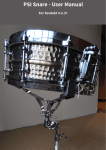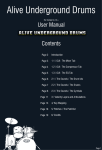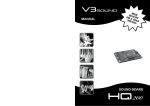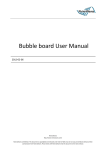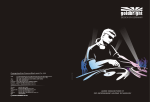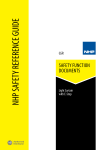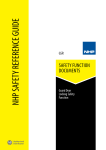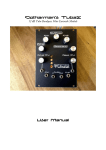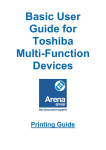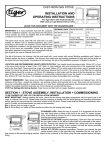Download PSI Marimba - User Manual 2 copy
Transcript
PSI Marimba - User Manual For Kontakt 4.2.3+ Overview The PSI Marimba is a 52 note, 3.2GB (compressed) virtual instrument using Native Instrument's .ncw lossless compression format samples. Each note of the Robert Van Sice Artist Series 4 1/3 Octave Rosewood Marimba has been meticulously sampled in our cinematic live room with 9 microphones (1 x mono and 4 x stereo) and up to 23 velocity levels. Each note of the main instrument has been individually phase aligned between microphones to give superb focus. There are 2 core instruments: • 'Main' with felt beaters (contains rolls and straight hits) • 'Soft' with softer beaters (contains rolls and straight hits) The Main instruments also have a 'Less Stereo Width' version with a narrower stereo field for situations where the natural width of the instrument needs to be reduced. There are also extended range versions of these to give you 5 octaves 5 bonus patches are also included which have a hard rubber beater, drag strokes (with a felt beater) and 5th, Minor 3rd and Major 3rd intervals also with the standard felt beater. All sampling involved 9 mics in 5 positions: Close Mics: • Center (Neumann TLM 103) • Stereo (Neumann KM184 pair) • Wide (AKG C414 B-ULS pair) Ambient Mics: • Ribbon (Coles 4038 pair) • Room (Neumann u87 pair) The resulting instrument is playable in the full retail version of Kontakt V4.2.3+ (not the free Kontakt Player) Contents • 15 patches in NKI format • 10,221 stereo samples at 24bit 44.1khz • Original user interface and advanced custom scripting engine. Patches • PSI Marimba Main w Rolls.NKI • PSI Marimba Main w Rolls ER.NKI • PSI Marimba Main.NKI • PSI Marimba Soft w Rolls.NKI • PSI Marimba Soft w Rolls ER.NKI • PSI Marimba Soft.NKI • PSI Marimba Main w Rolls LSW.NKI • PSI Marimba Main LSW.NKI • PSI Marimba Soft w Rolls LSW.NKI • PSI Marimba Soft LSW.NKI • PSI Marimba Rolls Short.NKI • PSI Marimba Rolls Soft Long.NKI • PSI Marimba Bonus 5ths.NKI • PSI Marimba Bonus Drag Stroke.NKI • PSI Marimba Bonus Maj3rd.NKI • PSI Marimba Bonus Min3rd.NKI • PSI Marimba Bonus Rubber.NKI This instrument presented undoubtedly our greatest sound capture challenge to date, mainly due to its size - the 4 1/3 octaves are around 6 foot long! This meant that 5 mics were needed just to close mic it. Then we felt that alongside our standard room mics, a pair of Coles Ribbons would also be useful to capture the beautiful natural 'woody' feel of the Marimba in the room. The phase alignment of the audio was essential to the main instruments to ensure a focussed tone, this had to be done for each note at every velocity.. We decided to go for up to 23 velocity layers instead of our usual velocity crossfading technique. This made for over 10,000 samples - a huge undertaking. The end result is amazing, it really does the instrument justice and represents a forensic, audiophile recreation of a world class instrument. System Requirements • Full version of Kontakt 4.2.3 or above - Not for Kontakt Player • 3.2 GB of free disc space Installation The library is supplied as a single Zip file. This is a compressed folder that you can open using the built-in tools on your computer. Open the file by double clicking and it will decompress the contents. Once decompression is complete you will have a single folder, this contains all the files needed to use the sample library. Simply copy this folder to the drive where you store your samples. For top performance it is recommended to keep sample libraries on a different drive to that of the OS and program files. Running The Library Once inside Kontakt, if you open the file tab in the browser window on the left-hand side you can browse to the instruments of the newly installed sample library. Just double click the NKI you wish to use and Kontakt will load it up. Alternatively you can drag the NKI from your standard OS explorer window into the Kontakt interface. You can also make use of Kontakt's Quick Load feature to make it even easier to load libraries into Kontakt Please refer to the Kontakt user manual for more information. The Interface 1. ‘Close’, ’Stereo‘, ’Wide‘, ’Ribbon’ and ‘Room' faders relate to the volume levels of each of the microphone positions. 2. ’Close‘, ’Stereo‘, ’Wide‘, ’Ribbon’ and ‘Room’ edit buttons allow the user to select filter controls and ADSR settings that relate to this microphone position. 3. ’ADSR’ is a standard amplitude envelope ... meaning that: A = Attack (Time taken for the initial level to travel from nil to peak beginning when the note is pressed) D = Decay (Time take for the subsequent run down from attack level to the designated sustain level) S = Sustain (The level during the main sequence of the sound duration until the key is released) R = Release (Time take for the level to decay from the sustain level back to zero after the note is released) 5. 1. 2. 6. 4. 8. 3. 7. 4. ‘Global' button selects filter to control all microphone positions (default ON). 5. ’HPF' (high pass filter) allows bass roll off at 12db per octave between 20hz and 800z 6. ‘LPF' (low pass filter) allows treble roll off at 12 db per octave between 20khz and 50hz 7. ’Reverb' Button on/off. ‘Dry' level- Controls the level of the dry portion of the signal. ’Wet' level- Controls the level of the wet portion of the signal. There are 10 preset reverbs to select based on the following convolution impulses: • Small= L224 ambience 0.25 (digital reverb) • Studio= Music Studio A (real rooms) • Church =Cathedral B (real rooms) • S plate =L96 plate small A (digital reverbs) • M plate = E252 2.2 s (real plate) • 1 plate = L480 7.1 s (digital reverbs) • FX verb 1= 1.s reverser, Opacity (special fx) • FX verb 2 = anomalous rhythm (special fx / mix) • FX verb 3 = rezo breath orven (unusual reverbs) • Lo-fi = grammophon 3 8. Rolls(on/off) click star to choose between straight hits and rolls. This is only available on patches with rolls (w rolls). This function is also operated be a dynamic keyswitch on midi note:C1. TIPS: To reset any control to its original value hold <<ctrl>> while clicking the knob. To adjust any control with finer precision hold <<shift>> while moving the knob. To automate any control right click on an interface function, select MIDI learn and send MIDI information from your control surface. Now record your desired MIDI automation into your DAW. What Kit Was Used? We carried out extensive microphone shoot outs to ascertain the correct microphones, pre-amps and positioning. We used the most effective resulting combinations, which were as follows: Close • Neumann TLM 103 • API 3124 preamp • Prism Conversion Stereo • Neumann KM184 pair • API 3124 preamps • Prism Conversion Wide • AKG C414-BULS pair • ISA 428 preamps • Prism Conversion Ribbon • Coles 4038 pair • SSL preamps • Prism Conversion Room • Neumann u87 pair • ISA 428 Preamps • Prism Conversion Where Was The Instrument Recorded? Studio 2 of Paper Stone Studios, Nottingham, England. What Makes Studio 2 So Special? Studio 2 is a converted cinema auditorium dating back to 1914. It's floor space is large at around 1400 Sq. foot. The incredible acoustics of the room are down to 3 factors: • An arched ceiling, which acts to reduce standing waves. • A false floor covering the old staggered seating platforms, which acts as a bass trap. • Engineered Acoustic treatment, in the form of rock wool screens and baffles. What are Rolls? Rolls are simply a single note hit with 2 beaters in a fast yet steady flow. This simply cannot be emulated well in MIDI so was essential to the sampling process. Credits Sam Brown / Tom Smith Player, Recordist, Sound Editor and Designer David Healey Scripting, Programming, Technical Support Glyn Lloyd [Sampleism] GUI Design, Coordinator The PSI Marimba is available exclusively at: Sampleism.com Also by Paper Stone: PSI Vibraphone PSI Palm Mute Piano The Clap V2 Creative Junk E.U.L.A. This End-User license agreement (EULA) is a legal agreement between you and Paper Stone Instruments for the Paper Stone Instruments product that this agreement accompanies; including computer software and associated media or multimedia, printed materials and electronic documentation. By installing or using this product you agree to be bound by the terms of the EULA. If you do not agree to the terms of this EULA you may not install or use the product. All audio samples provided with the product are the property of Paper Stone Instruments and are licensed to you, they are not sold. 1. Paper Stone Instruments grants the end-user (licensee) of the product the right to create finished musical works and performances using the audio samples and any other media or software included as part of the Paper Stone Instruments product. 2. The licensee may use the product for commercial purposes. 3. The licensee may alter the samples within the context of a finished musical work but may not distribute those altered samples outside of that musical context. 4. The creation of sound libraries in any form for commercial use or otherwise that use the Paper Stone Instruments audio or software, including single samples, loops, audio clips or similar is strictly prohibited. Violations will be prosecuted under local and international copyright law. 5. You may not under any circumstance make any part of the Paper Stone Instruments product available to others either by duplication, copy, distribution, transfer, upload, download, trade, resale, or loan. 6. The licensee may use this product on multiple computers under the following conditions: a. The use of multiple computers is part of a single audio workstation for the individual licensee. b. The licensee has two non-concurrent sites of work, such as a studio desktop and a laptop for live performance. 7. Paper Stone Instruments warrants and asserts that all audio samples, graphics, images, scripts, documents, and any other media included with the product is the sole property of Paper Stone Instruments and that Paper Stone Instruments has the authority to grant the rights in this EULA. 8. The user agrees to read the manual before seeking help or support from Paper Stone Instruments. 9. Paper Stone Instruments will not be responsible if the content of the product does not meet the particular purposes of the licensee. 10. It is the licensee's responsibility to check that the product is compatible with their computer system. 11. The product is licensed ?as is?. Paper Stone Instruments will not be responsible for any loss incurred by the licensee from the direct or indirect use of the product. 12. If you have any doubts, concerns, or uncertainties about the terms in this EULA please contact Paper Stone Instruments before installing or using the product. Copyright Paper Stone Instruments 2015









